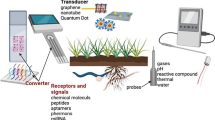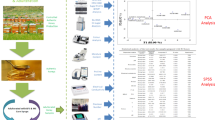The objective of this study was to confirm whether near-infrared spectroscopy could be used to discriminate the infected silkworm chrysalises. A total of 105 silkworm chrysalises — 65 infected and 40 uninfected — were collected at Beijing Shoucheng Agricultural Development Co., Ltd. Near-infrared spectra were acquired at the head, chest, abdomen, and posterior belly of each silkworm chrysalis (both uninfected and infected). Three spectral pre-processing methods and four discrimination models were used to identify the uninfected and infected silkworm chrysalises. Results indicated that the PLS–DA model based on the spectra processed by multiplicative scatter correction (MSC) had the best discrimination performance (the prediction accuracy of calibration set and prediction set were 100 and 97.5%, respectively), and the head portion was the best position for the discrimination of uninfected and infected silkworm chrysalises. The overall conclusion was that the uninfected and infected silkworm chrysalises could be successfully identified by using near-infrared spectroscopy technology in the cultivation of Cordyceps militaris.
Similar content being viewed by others
References
G. H. Sung, N. L. Hywel-Jones, J. M. Sung, J. J. Luangsaard, B. Shrestha, and J. W. Spatafora, Stud. Mycol., 57, 50–59 (2007).
S. X. Bi, Y. S. Jing, and Q. Q. Zhou, Food Funct., 9, No. 1, 279–293 (2018).
K. Nakamura, K. Shinozuka, and N. Yoshikawaa, J. Pharmacol. Sci., 127, No. 1, 53–56 (2015).
Z. Y. Zhu, F. Liu, H. Gao, H. Sun, M. Meng, and Y. M. Zhang, Int. J. Biol. Macromol. A, 93, 1090–1099 (2016).
X. W. Tian, Q. P. Song, M. He, Y. L. Lu, Y. C. Liu, and L. S. Feng, Biosci. Biotech. Res. Commun., 9, No. 4, 596–602 (2016).
H. T. Fan and H. S. Lin, Chin. J. Chin. Mater. Med., 38, 2549–2552 (2013).
H. O. Kim and J. W. Yun, J. Appl. Microbiol., 99, 728–738 (2005).
Z. L. Zheng, C. H. Huang, C. Y. Mei, and R. C. Han, J. Environ. Entomol., 33, 225–233 (2011).
R. R. M. Paterson, Phytochemistry, 69, 1469–1495 (2008).
Y. F. Han, Microbiol. China, 32, 1423–1428 (2009).
X. L. Chu and W. Z. Lu, Spectrosc. Spectr. Anal., 34, 2595–2605 (2014).
H. Z. Chen, L. L. Xu, G. Q. Tang, Q. Q. Song, and Q. X. Feng, Food Anal. Methods, 9, 1–10 (2015).
Y. He and X. L. Li, J. Infrared Millim. Waves, 25, 192–194 (2006).
H. E. Tahir, X. B. Zou, T. T. Shen, J. Y. Shi, and A. A. Mariod, Food Anal. Methods, 9, 2631–2641 (2016).
S. M. Pan, M. Tao, A. Q. Sun, and T. M. Jin, Acta Entomol. Sin., 39, 360–365 (1996).
F. Dai, L.Wu, G. Ye, Y. Zhong, T. Hong, and X. Huang, Trans. Chin. Soc. Agric. Mach., 46, No. 12, 280–284 (2015).
J. Engel, J. Gerretzen, E. Szymańska, J. Jansen, G. Downey, L. Blanchet, and L. Buydens, TrAC Trends Anal. Chem., 50, 96–106 (2013).
R. Vašát, R. Kodešová, A. Klement, and L. Borůvka, Geoderma, 298, 46–53 (2017).
Y. Zhao, J. Zhang, H. Jin, J. Zhang, T. Shen, and Y. Wang, J. AOAC Int., 98, 22–26 (2015).
B. T. Borille, M. C. Marcelo, R. S. Ortiz, K. C. Mariotti, M. F. Ferrão, and R. P. Limberger, Spectrochim. Acta A, 173, 318–323 (2016).
E. Teye, X. Huang, H. Dai, and Q. Chen, Spectrochim. Acta A, 114, 183–189 (2013).
L. L. Tao, W. Huang, X. J. Yang, Z. Y. Cao, J. M. Deng, S. S. Wang, F. Y. Mei, M. W. Zhang, and X. Zhang, Spectrosc. Spectr. Anal., 36, 2766–2773 (2016).
T. Koumbi-Mounanga, K. Groves, B. Leblon, G. Zhou, and P. A. Cooper, Eur. J. Wood Prod., 73, 43–50 (2015).
F. Mabood, F. Jabeen, M. Ahmed, J. Hussain, S. A. A. Al Mashaykhi, Z. M. A. Al Rubaiey, S. Farooq, R. Boqué, L. Ali, Z. Hussain, A. Al-Harrasi, A. L. Khan, Z. Naureen, M. Idrees, and S. Manzoor, Food Chem., 221, 746–750 (2017).
Author information
Authors and Affiliations
Corresponding author
Additional information
Abstract of article is published in Zhurnal Prikladnoi Spektroskopii, Vol. 88, No. 1, p. 169, January–February, 2021.
Rights and permissions
About this article
Cite this article
Zhang, Y., Wang, X., Wang, C. et al. Discrimination of Infected Silkworm Chrysalises using Near-Infrared Spectroscopy Combined with Multivariate Analysis during the Cultivation of Cordyceps militaris. J Appl Spectrosc 88, 187–193 (2021). https://doi.org/10.1007/s10812-021-01157-9
Published:
Issue Date:
DOI: https://doi.org/10.1007/s10812-021-01157-9




